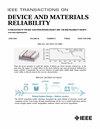逻辑细胞对激光故障注入的敏感性:IHP技术的实验结果综述
IF 2.3
3区 工程技术
Q2 ENGINEERING, ELECTRICAL & ELECTRONIC
IEEE Transactions on Device and Materials Reliability
Pub Date : 2025-08-06
DOI:10.1109/TDMR.2025.3596380
引用次数: 0
摘要
在这项工作中,我们概述了我们的前端故障注入(FI)实验,这些实验采用两种IHP BiCMOS技术制造的不同逻辑单元,使用Riscure设备用于激光FI。我们能够将故障注入不同类型的细胞,包括标准库细胞,以及两种耐辐射人字拖。在耐辐射触发器实验中,将PMOS晶体管注入到处于OFF状态的照射区域。我们确定了对激光FI攻击敏感的细胞区域。在以往的研究中,将纳米mos晶体管确定为逻辑单元的敏感部分的研究很少。关于对激光FI攻击敏感的区域的知识可以推广到其他技术的实验中,并在未来被设计人员用于在芯片开发的初始阶段实施相应的对策。本文章由计算机程序翻译,如有差异,请以英文原文为准。
Sensitivity of Logic Cells to Laser Fault Injections: An Overview of Experimental Results for IHP Technologies
In this work, we provide an overview of our front-side Fault Injection (FI) experiments with different logic cells manufactured in two IHP BiCMOS technologies using Riscure equipment for laser FIs. We were able to inject faults into different types of cells including standard library cells as well as into two types of radiation tolerant flip-flops. Experimenting with radiation-tolerant flip-flops faults were injected illuminating areas with PMOS transistors in OFF state. We determined the cells areas, which were sensitive to the laser FI attacks. Only few works discussed this aspect in the past determining NMOS transistors as the sensitive part of the logic cells. Knowledge about the areas which are sensitive to the laser FI attacks can be generalized experimenting with other technologies and used in future by designers to implement corresponding countermeasure(s) at the initial stage of chip development.
求助全文
通过发布文献求助,成功后即可免费获取论文全文。
去求助
来源期刊

IEEE Transactions on Device and Materials Reliability
工程技术-工程:电子与电气
CiteScore
4.80
自引率
5.00%
发文量
71
审稿时长
6-12 weeks
期刊介绍:
The scope of the publication includes, but is not limited to Reliability of: Devices, Materials, Processes, Interfaces, Integrated Microsystems (including MEMS & Sensors), Transistors, Technology (CMOS, BiCMOS, etc.), Integrated Circuits (IC, SSI, MSI, LSI, ULSI, ELSI, etc.), Thin Film Transistor Applications. The measurement and understanding of the reliability of such entities at each phase, from the concept stage through research and development and into manufacturing scale-up, provides the overall database on the reliability of the devices, materials, processes, package and other necessities for the successful introduction of a product to market. This reliability database is the foundation for a quality product, which meets customer expectation. A product so developed has high reliability. High quality will be achieved because product weaknesses will have been found (root cause analysis) and designed out of the final product. This process of ever increasing reliability and quality will result in a superior product. In the end, reliability and quality are not one thing; but in a sense everything, which can be or has to be done to guarantee that the product successfully performs in the field under customer conditions. Our goal is to capture these advances. An additional objective is to focus cross fertilized communication in the state of the art of reliability of electronic materials and devices and provide fundamental understanding of basic phenomena that affect reliability. In addition, the publication is a forum for interdisciplinary studies on reliability. An overall goal is to provide leading edge/state of the art information, which is critically relevant to the creation of reliable products.
 求助内容:
求助内容: 应助结果提醒方式:
应助结果提醒方式:


